Description: War Thunder is a next generation military MMO game dedicated to...


Every woman had to sew curtains with her own hands, at least for the kitchen or for giving. It is quite difficult to sew a curtain on your own beautifully, neatly and correctly, it is especially difficult to sew lambrequins. Even if there are accurate patterns and a good sewing machine, experience and knowledge of curtain sewing technology is required.
Sewing a Japanese or Roman curtain so that they are as beautiful and neat as in the photo in online stores can only be done by atelier professionals. The same applies to other complex models of curtains (French, Austrian) as well as curtains decorated with lambrequins. But, if you have a good sewing machine and you like to sew, then sewing a simple model of organza or tulle curtains on the windows for the kitchen, nursery and even in the hall, decorating them with tiebacks, is quite possible on your own. And if you consider that in stores you can buy a variety of eyelets, beautiful fittings and other decorative ornaments for curtains, then a simple model of a curtain can be turned into a work of art.

If you decide sew a curtain with your own hands it is important to correctly measure the height and width of the future curtain and cut it evenly (align the edges of the curtain). The slightest inaccuracy in the measurement gives a significant error in general. And the curtain will be either short, or "creep" along the floor, or even completely skewed. It is especially difficult to align inexpensive tulle and drape fabrics that do not have a pattern.
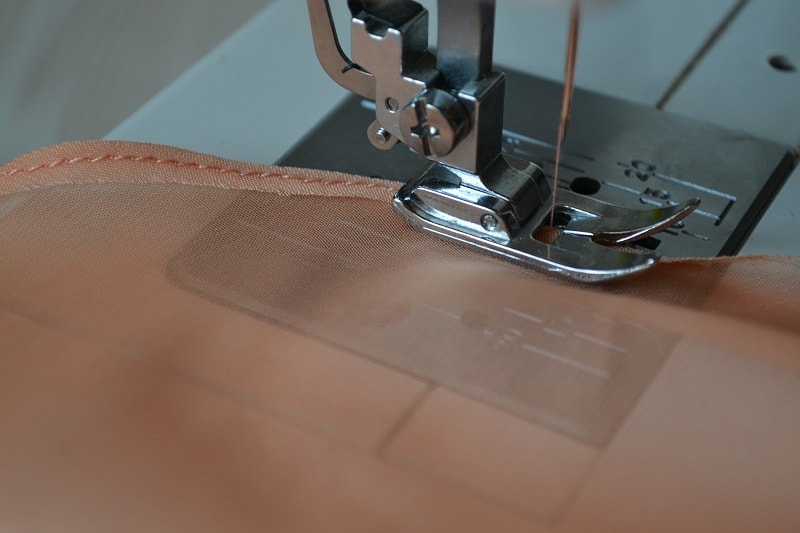
Decide in advance how you will process the edges of the curtains. In a hem, with an oblique trim or a rolled seam. True, the latter option requires an overlock that performs a two-thread role-playing seam.
Calculate in advance how much bias tape and curtain tape will be needed. Please note that curtain tape has a different coefficient of assembly formation (1.5/ 2/ 2.5). So, with a curtain width of 200 cm, you will need to buy a curtain tape (with a coefficient of 1.5) - 300 cm. The width of the curtain should be the same (3 meters). After pulling the curtain tape with cords, it will decrease to 2 meters.
Buy everything you need right away, along with curtain fabric. Not only curtain braid, but also threads, oblique trim. Just do not forget to make a small "margin" for all your calculations.
A wide transparent curtain tape is used for sewing organza or tulle curtains. A wide fabric-based curtain braid is used for sewing curtains from curtain fabric, lambrequins. A narrow curtain tape, most often, is necessary when sewing curtains, curtains, lambrequins, without wrinkling.
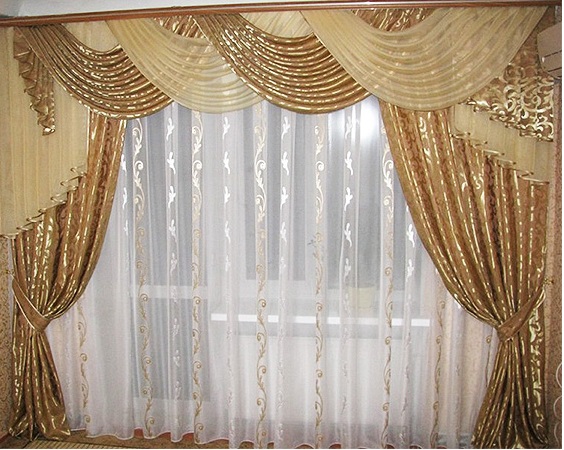
To sew a curtain yourself with beautiful and evenly finished edges, you need not only a good sewing machine, but also the ability to perform certain operations.
It is not difficult to process the edge with a rolled seam on an overlock, but it is not easy to process the edge "in a hem" or with an oblique trim. An experienced seamstress does not even iron the cut edge of the curtain and can make a hem without a special foot, laying a neat line (0.1 mm) along the edge of the hem. You may also have to iron the edge of the curtain hem in two stages, and then also sweep it with a thread. The same applies to curtain tape.
If you have never sewed lambrequins or other complex elements for curtains, it’s better to start with simple models for giving or kitchen on small window and according to the finished pattern. It is quite difficult to lay a swag or lambrequin in beautiful folds without experience. Here you need to take into account the quality of the fabric, and the size of the swag and the direction of the shared fabric when cutting, and know many other secrets. Please note that lambrequins are laid out with beautiful folds only in the photo in the catalogs of curtains.
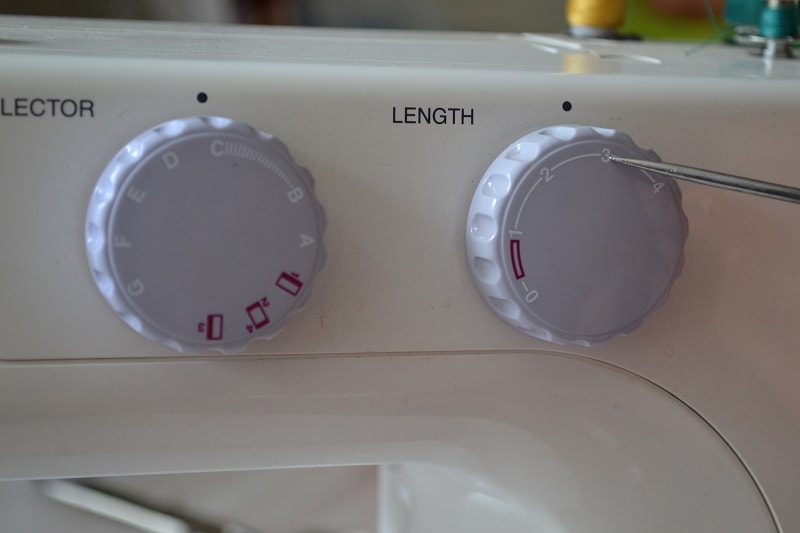
To sew your own curtain need to know technological features sewing curtain and tulle fabrics and the possibilities of your sewing machine. Be sure to select the appropriate thickness of thread and needle. Sewing threads should be thin, strong and elastic. It is better to immediately put in a new needle, since a blunt or bent needle on many fabrics will leave puncture marks and form puffs.
Before sewing curtains, you need to correctly adjust the thread tension and the presser foot pressure on the fabric. Adjust the height of the rack teeth so that the organza or tulle does not "gather" during sewing. Highly raised slat teeth are needed only for sewing cloth and drape fabrics. For thin fabrics, the teeth should be lowered as low as possible, while checking the pressure of the presser foot on the fabric. See Setting the cloth advance .
If one of these conditions is not met, the seam will most likely be tightened, and you will not smooth it out with any iron.
To reduce the fit of the fabric when sewing curtains, some seamstresses simply pull the edge of the curtain with their hand towards themselves. This should not be done, as this "method" can break the needle and stretch the edge of the curtain. As a result, the edge of the curtain will be wavy. It is better to pull, but not stretch, the area with both hands, then you can avoid a strong fit of the fabric.
Do not set too small a stitch, the curtains will not become stronger from this. But if you have to dissolve the line, then it will take a lot of time. After all, the total length of the seams on one curtain can reach 15 meters.

curtain design for living room big room, often supplemented with a lambrequin. Lambrequins give the curtains a more complete look and allow you to hide the cornice and mounting tape, with which curtains or curtains are fixed. Lambrequins can be divided into three types:
hard (gang) - are strips of fabric reinforced with a special material;
soft - lush elements with assemblies forming a variety of shapes;
complex lambrequins - a combination of various draped details, the arrangement of which can be either symmetrical or asymmetrical.
Tassels and tiebacks are perhaps the most commonly used in the design of the living room. Brushes can play the role of pickups, or have a purely decorative value. Small tassels located along the edges of the curtains give a special luxury.
Tiebacks help hold the curtains apart on the sides of the window, with their help the drapery is fixed.
Wide and narrow frills, pleats, bows and braids are often used to decorate tiebacks.
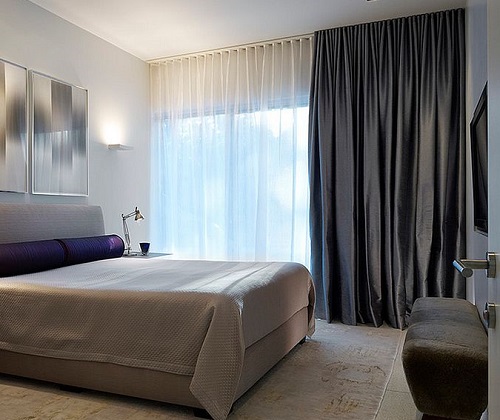
The splendor of soft draperies, curtain fabrics flowing to the floor, deep rich colors, or the simplicity and beauty of light pastel shades? Luxurious curtains to match the bedspread or weightless airy tulle as the main element, or maybe french curtains? Choose a style that is comfortable for you.
Bedroom design means that the color of textiles, furniture and walls should be combined with each other as much as possible, be in complete harmony with the carpet, flooring. To do this, it is best to use different shades of the main color in decoration and accessories. The pastel colors used in the curtains will definitely fill the bedroom with comfort and warmth.
Long curtains are best for the bedroom, they can be either very thick, not letting through. sunlight, or light and transparent. One of the requirements for bedroom curtains is good protection against sun rays, so the curtain fabric must have a high density.
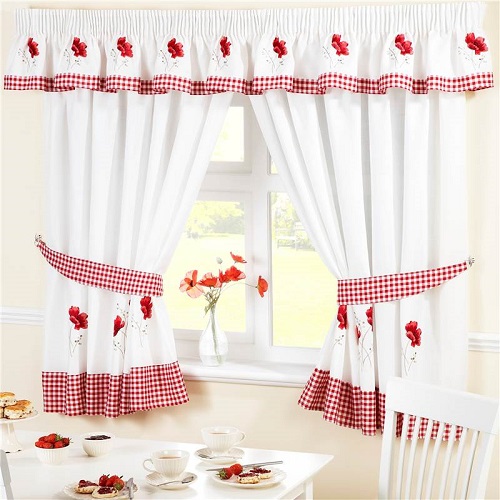
Many kitchens cannot yet "boast" of large sizes. And the presence of a stove, a refrigerator further reduces the useful area of the kitchen, so it is necessary that the curtains in the kitchen visually expand its space. Not too bright and not full of large patterns, the fabric is best suited for this. Also visually increases the space curtains, matched to the color of the walls of the kitchen.
It is better to hang transparent or translucent curtains on a small kitchen window without unnecessary bulky decorations, grabbing them on the sides with ribbons. The window will become lighter and appear larger.
Curtains with many folds, draperies on a small kitchen window will look rather ridiculous. This window design is only suitable for a large kitchen combined with a dining room.
If you decide sew curtains with your own hands and you have not-so-new chairs in the same room, think about how to sew covers on them. Fabric for covers can be used tighter than for sewing curtains. Therefore, calculate in advance how much fabric you need to buy for sewing curtains and how much for sewing furniture covers.
Bed linen, matched to the tone of the curtains in the bedroom, will additionally decorate your bedroom. And it doesn't matter that no one except you and your loved ones will appreciate it. Beautiful linens, in harmony with the curtains and the overall design of the bedroom, will definitely cheer you up.
Curtains very important element decorations for any room. Best for kitchen bright hues, in the hall and bedroom curtains with lambrequins, with tiebacks look good. The design of the room can be changed by sewing curtains of a certain model. For example, Roman blinds, roller blinds are well suited for the kitchen. Curtain design is the foundation to start with before sewing curtains.
New curtains always greatly change the interior of any room. I would like to change with them the "bored" furniture. Try simply sewing sofa covers and you will see how your furniture will change.
Probably nothing else, except for the color of the walls, is in harmony with the curtains like a bedspread. It is clear that you cannot sew curtains from the same fabric as the bedspread, since such a combination would be too "simple". But the general tone, maybe even the pattern of the fabric, it is advisable to match the main color of the curtains.
The master will share his experience on how to sew a pillow and how to build a pattern for any shape of a soft pillow.
Probably nothing warms the soul of the hostess so much as beautiful things made with their own hands. They say with all their appearance: “What a clever girl you are! And a needlewoman! And what is the first thing that catches your eye in the apartment? Of course the curtains. And to make them really beautiful and of high quality, you need to know some subtleties. Moreover, knowing these subtleties does not guarantee that the curtains will fit perfectly into the interior. Therefore, I decided to do a sort of mini-study and collect in it everything that can be useful in preparation for tailoring and directly when sewing curtains.
Having started collecting material, I understand that it is impossible to manage here with one post. Therefore, I begin to spread a series of articles under the general title. All images are clickable.
In the first part:
And I want to immediately note this feature: the type and style of curtains do not always match. For example, you can sew Roman curtains in ethnic style or Austrian curtains in Provence style.
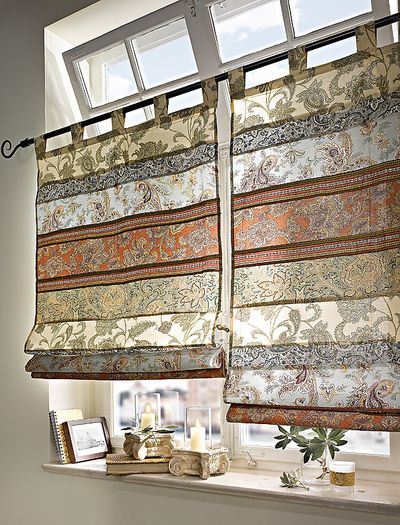
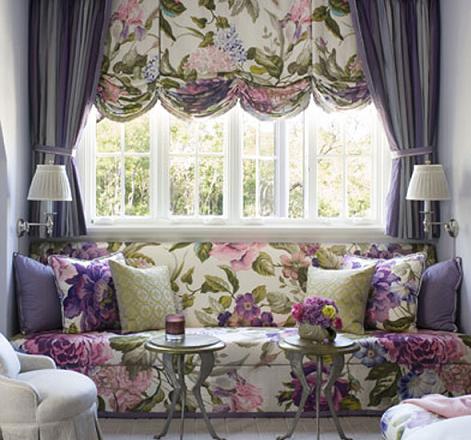
To begin with, let's define the style, it consists of several components: the size and shape of the window, the general style of the interior, your taste preferences. To understand all this, you need to know some concepts.
CURTAIN in Wikipedia - the general name of household functional and decorative window curtains made of fabric materials. Curtain (fr. store) in a particular case - a window curtain, moved apart to the sides or lifted up.

PORTIER(from French Portiere, derived from Porte - "door") in Wiktionary - port-tier-ra. 1. curtain (usually heavy fabric) on doors or windows, this term is used to refer to thick, heavy (lined) curtains.
![]()
CURTAIN(from German Gardine), according to the Yandex Dictionary, a curtain made of heavy fabric for an alcove niche, etc., and Wikipedia believes that there is a notion that does not correspond to the norms of the literary language, that the curtain is a massive stick on which the curtain is hung. A curtain (Dutch. Gordijne) is actually a soft curtain made of thin transparent fabric (tulle, organza, veil), covering the window completely or partially.
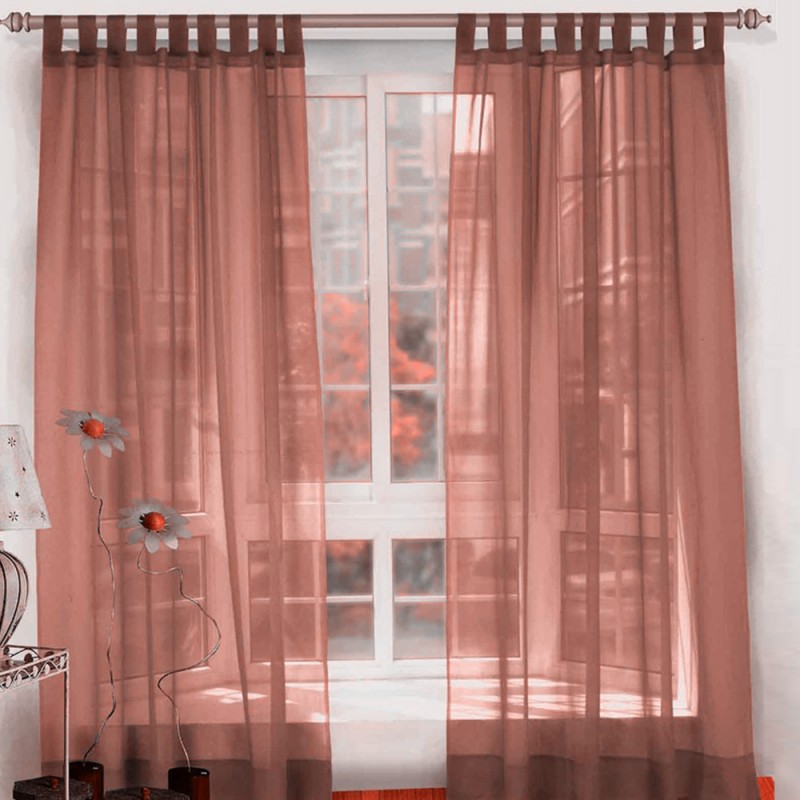
All curtains consist of elements that form one or another style.
(from French Lambrequin - decoration) - decoration in the form of drapery, which is placed in front of curtains or soft curtains and gives the window a decorative completeness, has many types and subspecies, is soft and hard;
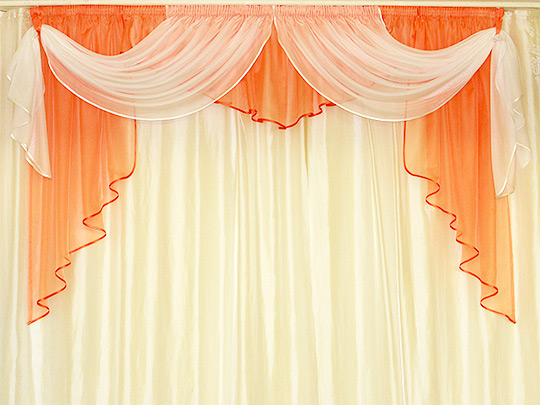
directly a curtain or curtain placed behind a lambrequin;
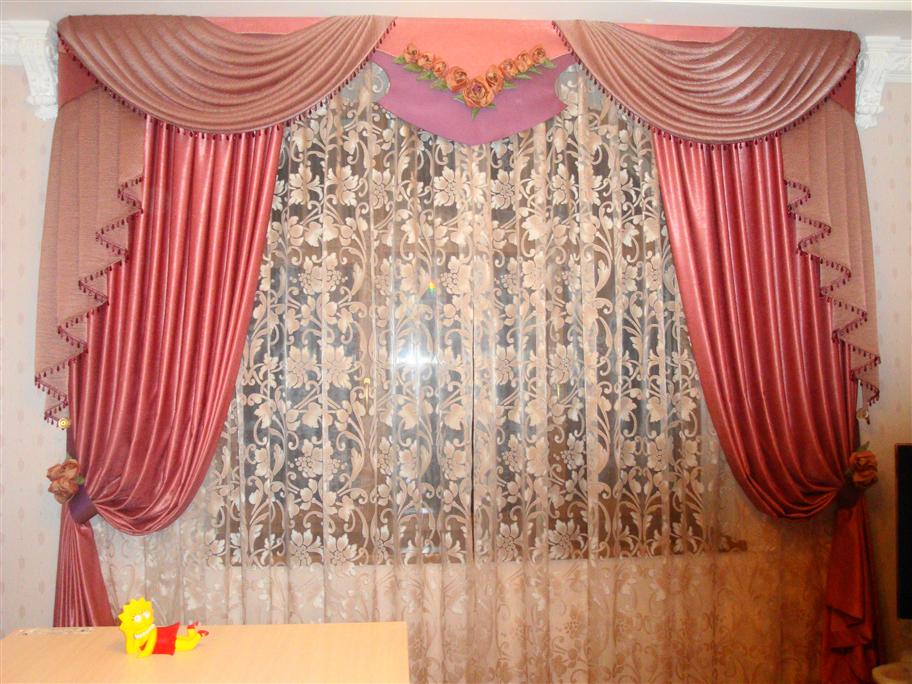
A part made of fabric or other material, for fixing curtains or curtains in the required position, can be of several types;
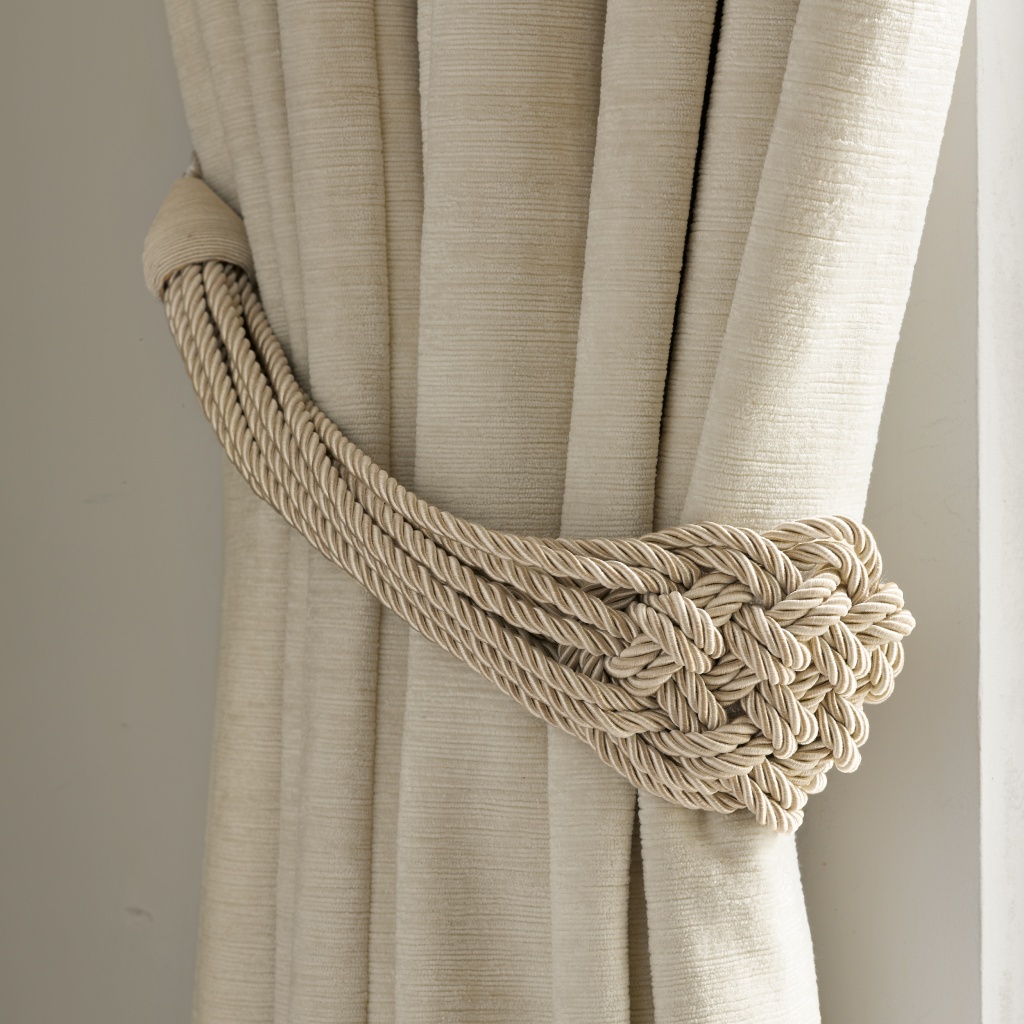
Processing method back side curtains or lambrequin, to give best view, to hide raw cuts, as well as for color (decorative) support of some interior elements;
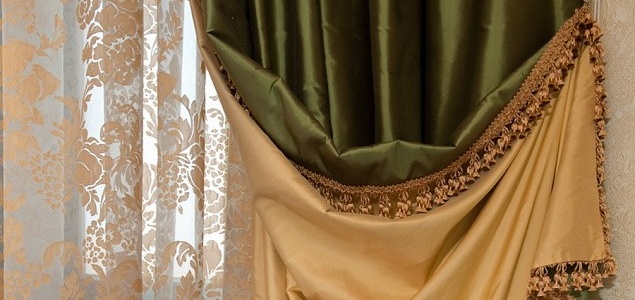
TYPES OF CURTAINS:
All species reflect the style of the era and the place of their origin.
- they are a plain fabric, gathered in uniform vertical folds along the entire length, creating a unique ceremonial atmosphere, they are installed on a rail cornice or on a cornice with a special lifting mechanism.
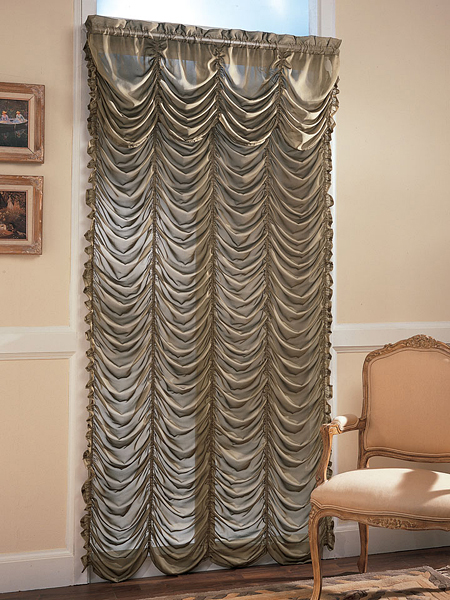
- just like French ones, they are horizontal folds of fabric collected along the bottom edge of the canvas. The curtain fabric can be fixed in the assembled state, or hang in the loose state. In these curtains, cords and special loops are sewn on the wrong side of the fabric, with the help of which beautiful scallops are obtained when pulled together and soft folds along the bottom of the curtain when loose. An Austrian curtain made of dense fabric will create a cozy classic atmosphere, and a light transparent fabric will create a romantic one. In addition, the Austrian curtain can hang both independently and with a lambrequin. With all the luxury, the curtains take up little space, so they are suitable for rooms with limited space. For installation, a special rail cornice with a device for attaching cords is used. 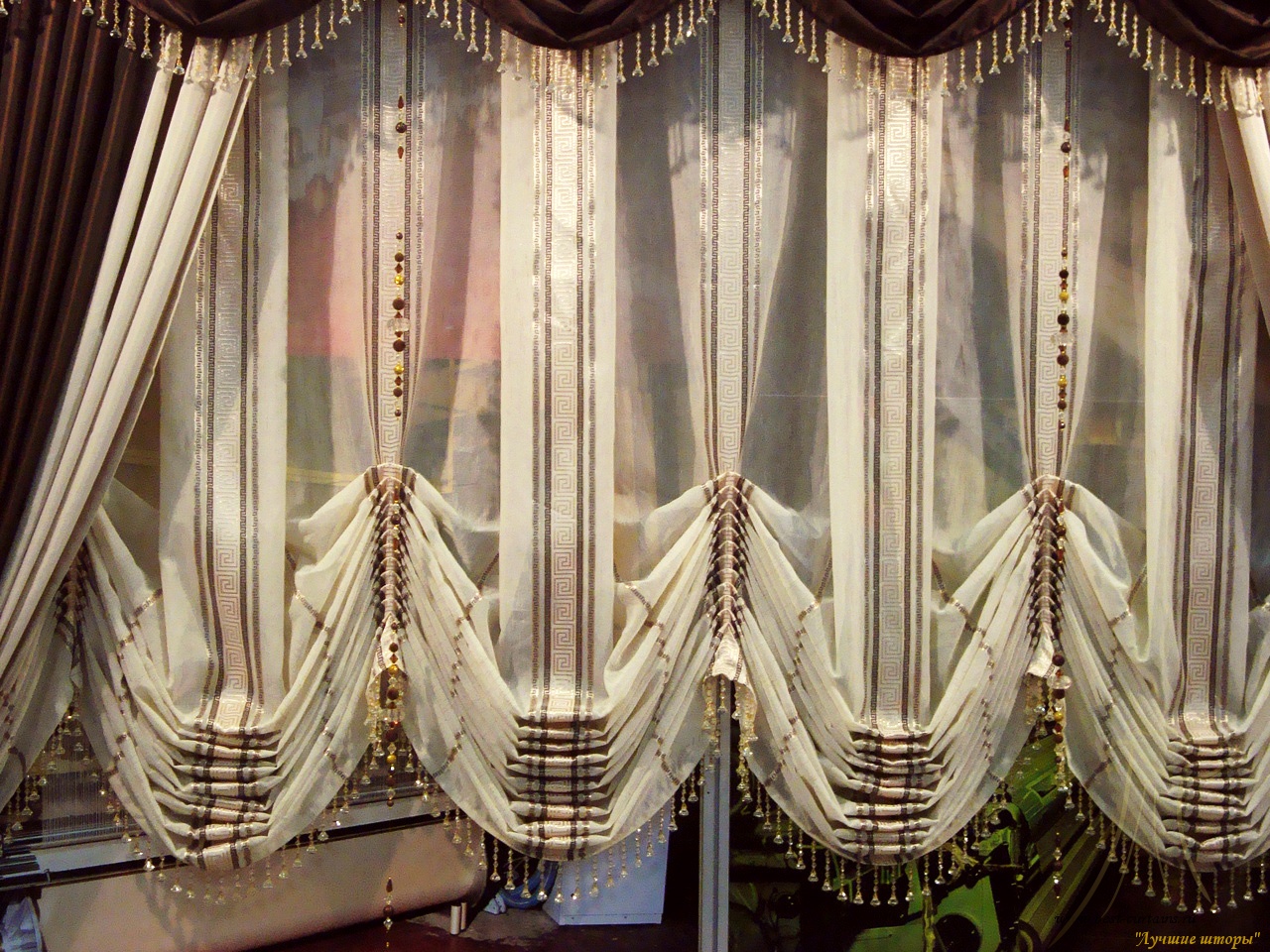
the curtains are distinguished by their original fastening - the fabric sheet does not move apart completely, and the tiebacks are in a higher position. The curtains are gracefully supported diagonally by cords that are attached to the ends of the cornice and create a beautiful silhouette of the window. This type of curtain looks good in narrow window openings and visually increases the height of the window. For Italian curtains, use a standard cornice with a rail or a curved cornice, which will perfectly emphasize the arched shape of the window. 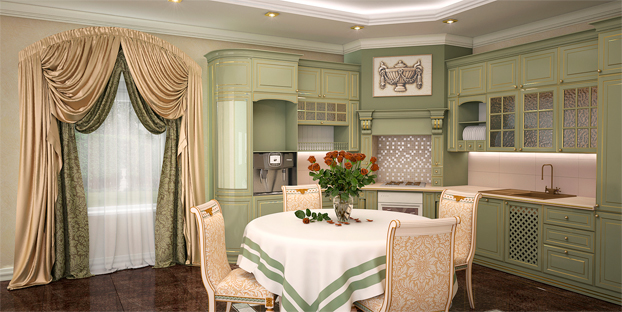
Roman curtains - their original purpose is to protect the room from prying eyes and unwanted light. The design of Roman curtains consists of horizontal folds, assembled by means of hard rails sewn in or fixed on the inside, moving with the help of cords and rings sewn onto the fabric. Curtains are universal and can be an element of the interior, decorated in any style. 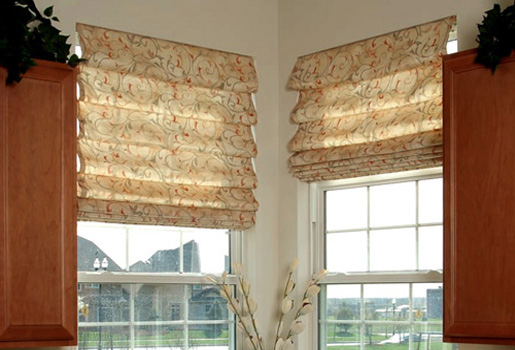
crossed curtains are formed from two panels crossed along top edge and attached to opposite sides of the window.
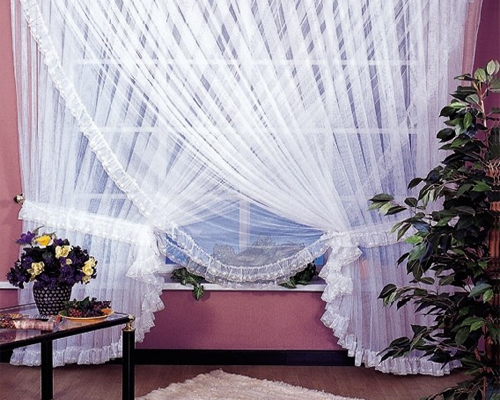
Roll (roller) curtains - are wound on a roller fixed at the top of the window. Ascent and descent roller blinds controlled by a spring mechanism that fixes the curtain in the open and closed position, or a rotary-chain mechanism that allows you to raise or lower the curtain fabric to the desired level. Can be with the left-hand and right-hand control mechanism. The advantage of these curtains is the possibility of using fabrics with dust-repellent impregnation and varying degrees of light transmission. The fabric can be easily replaced without changing the mechanism itself. Curtains can be used on their own, making the main accent or used as a functional element in combination with curtains or tulle. 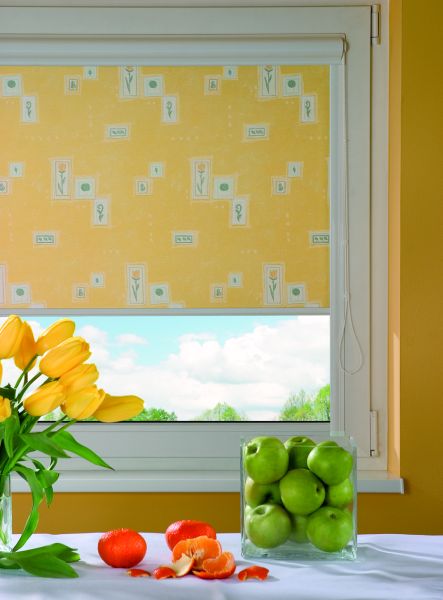
Curtains pleated- the simplest of all existing curtains but no less functional. They optimally distribute the light flux and combine, on the one hand, the clarity of the lines, and on the other hand, the warmth of the fabric. With the help of side control, they are easily folded like an accordion to the desired position. The use of dirt-repellent and sun-protective fabrics allows you to place them in places unfavorable for ordinary curtains, in the bathroom or in the garage, they are indispensable for the design of inclined and dormer windows, on windows of non-standard shape (arched, triangular), because due to their plasticity they repeat the shape of the window opening. 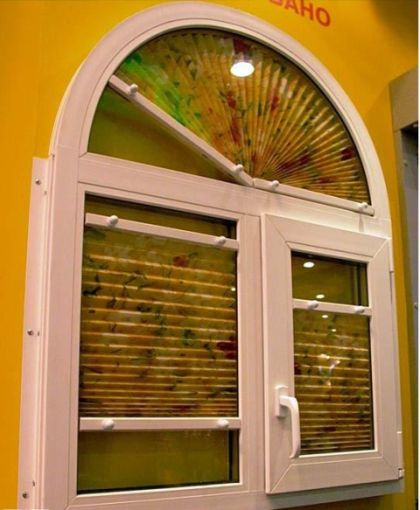
Japanese curtains - several solid, absolutely even canvases moving to the side, like a screen. Top and bottom - rigid inserts that do not allow them to fold. They differ from other types of window decoration in minimalism, restraint and conciseness, they are best suited for spacious rooms with large windows. They can also be used as a partition screen that divides the room into several zones. Another plus is that such a curtain almost does not collect dust. Any fabric is used. 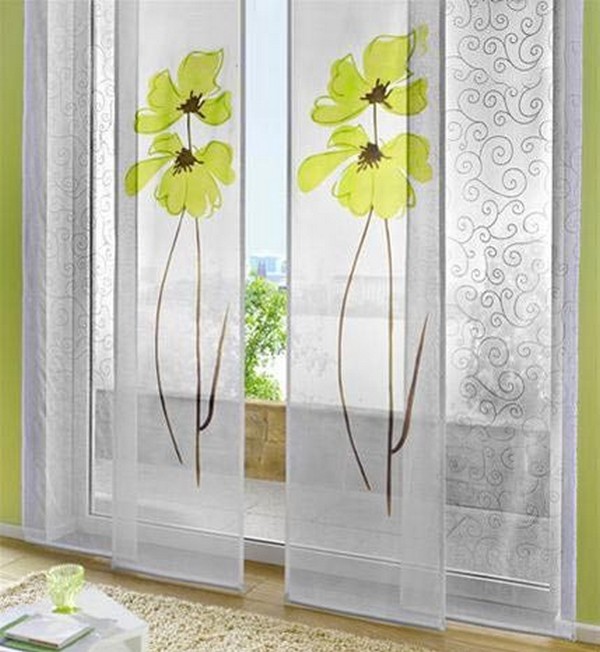
Panel (screen) curtains, resemble a screen and look very stylish and concise. Any fabric is stretched on special frame fasteners, and the panels themselves can easily move in the plane of the window, fixing in any desired position. Also, this mechanism can be used not only for window decoration, but also for creating decorative partitions in the room. For these curtains, only natural materials are used - hemp fabric made from trunks herbaceous plants, bamboo stalks, cotton and silk fabrics with the inclusion of fibers obtained from palm leaves as an accent. 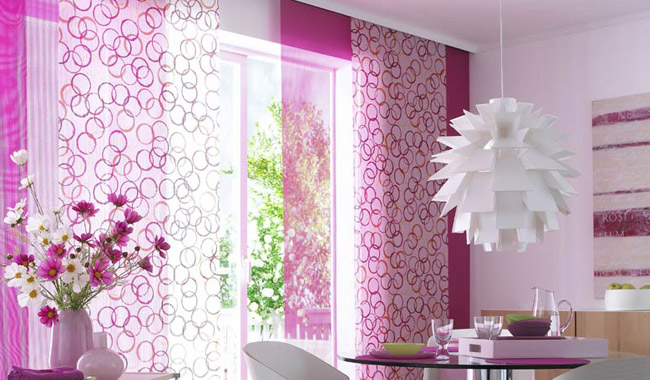
Curtains on eyelets and hinges Soft, straight creases created with eyelets are a great way to show off the beauty of a fabric. 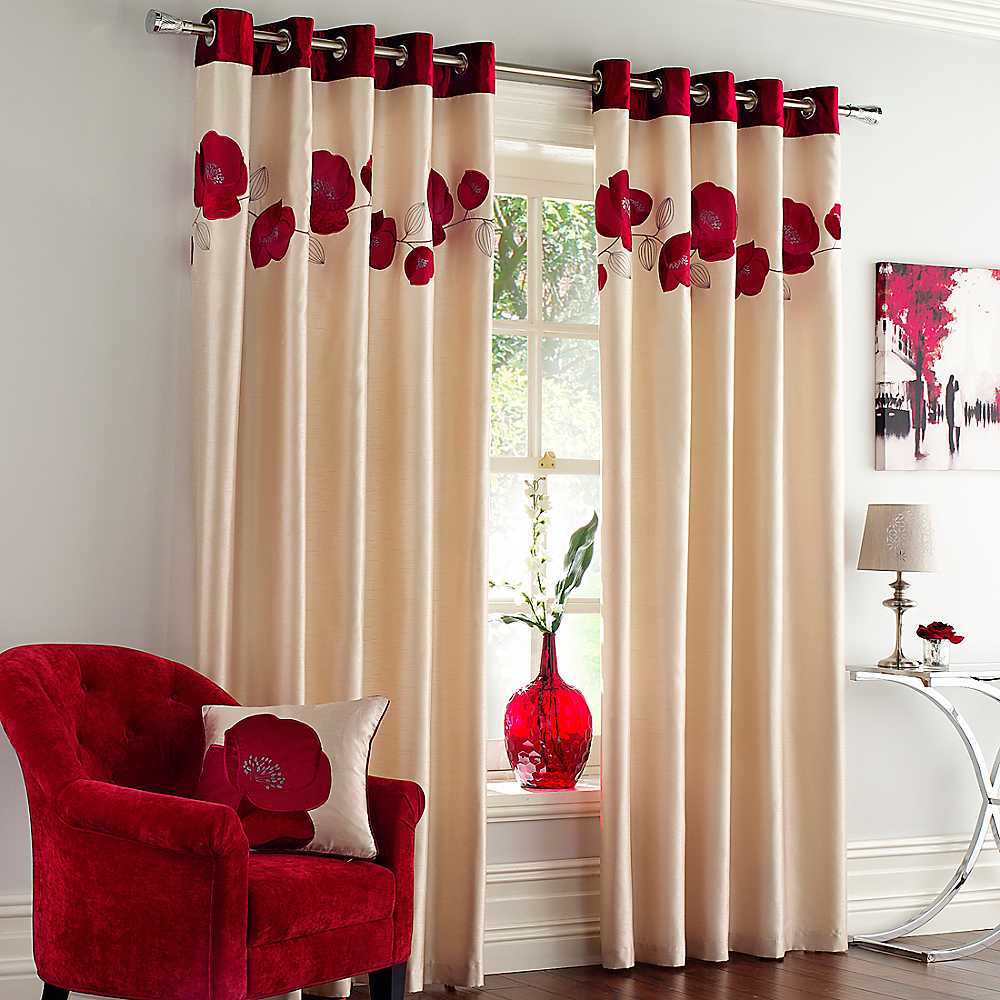
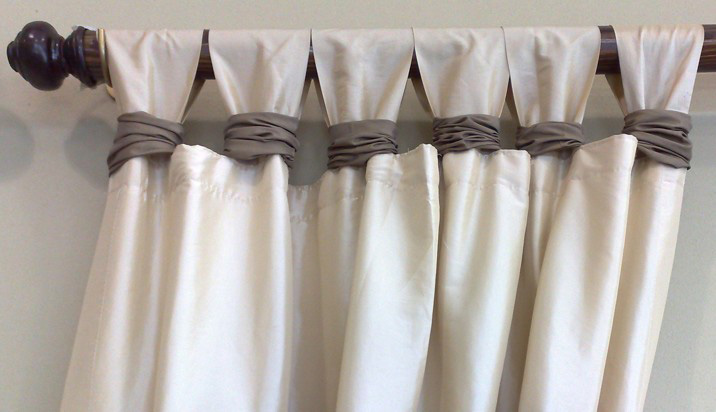
curtains - universal in use, light and practical, they are bamboo sticks sewn together. Cord control system: the curtain smoothly "wave after wave" unfolds down and assembles in a similar manner. 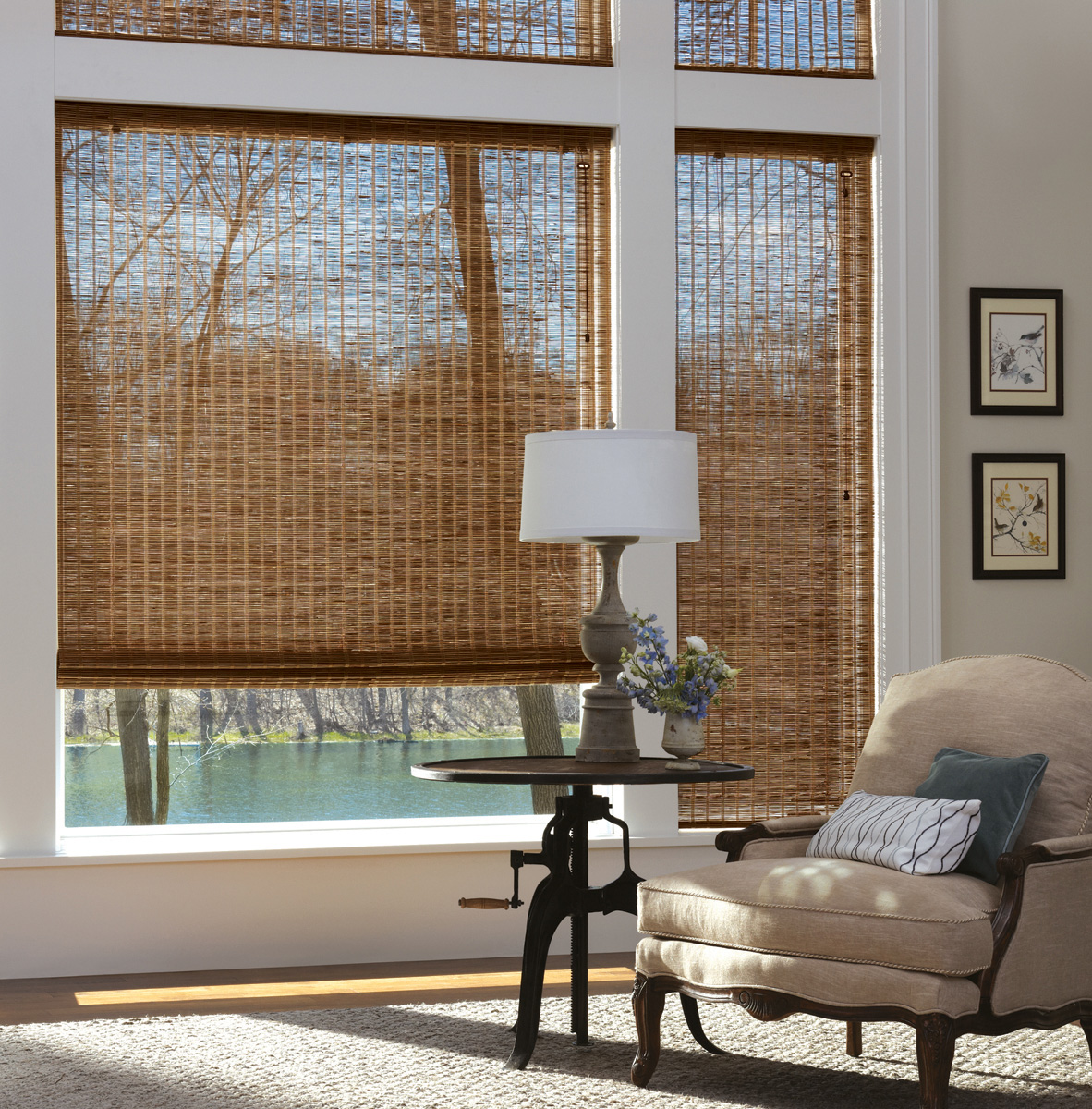
CURTAIN STYLE:
- involves the use of colorful national motifs of Arabs, Scandinavians, Indians, Africans, Japanese and other peoples, which are reflected in the interior. Ethnic style is divided into many segments. 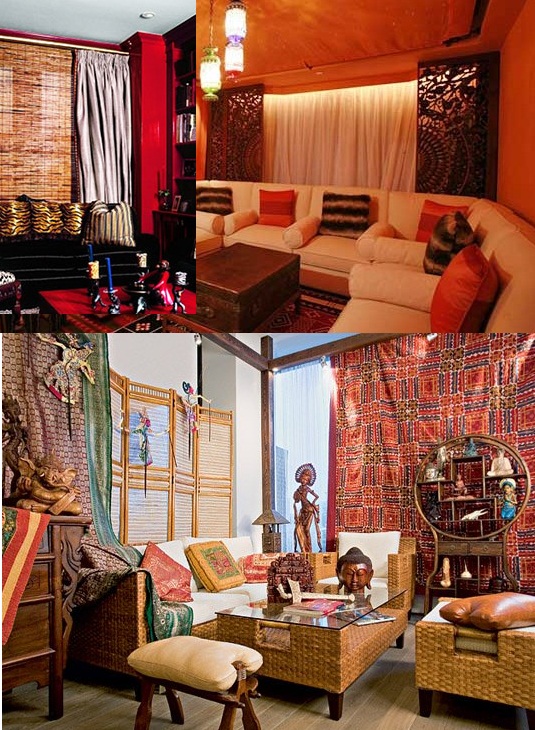
East style- a symbiosis of two oriental cultures: Arab and Asian, bright, multi-colored fabrics of rich, deep colors, richly embroidered with beads, shiny beads and cords. Oriental flavor will add light chiffon fabrics combined with heavy cords and tassels. 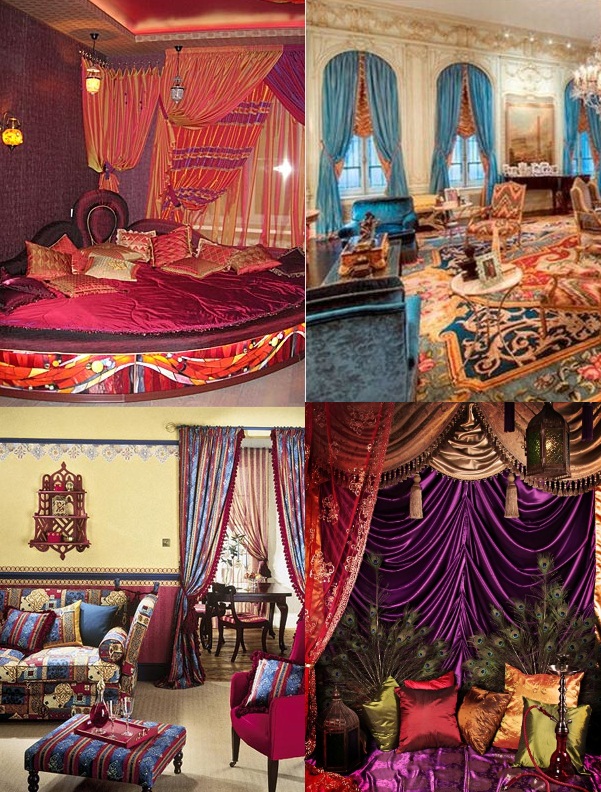
Japanese style- minimalism, conciseness, restraint. Curtains can take the form of partitions, panels and screens. They can give a minimalist home a discreet, uncluttered look. It is very easy to care for such curtains, and their choice of possible colors is very large. 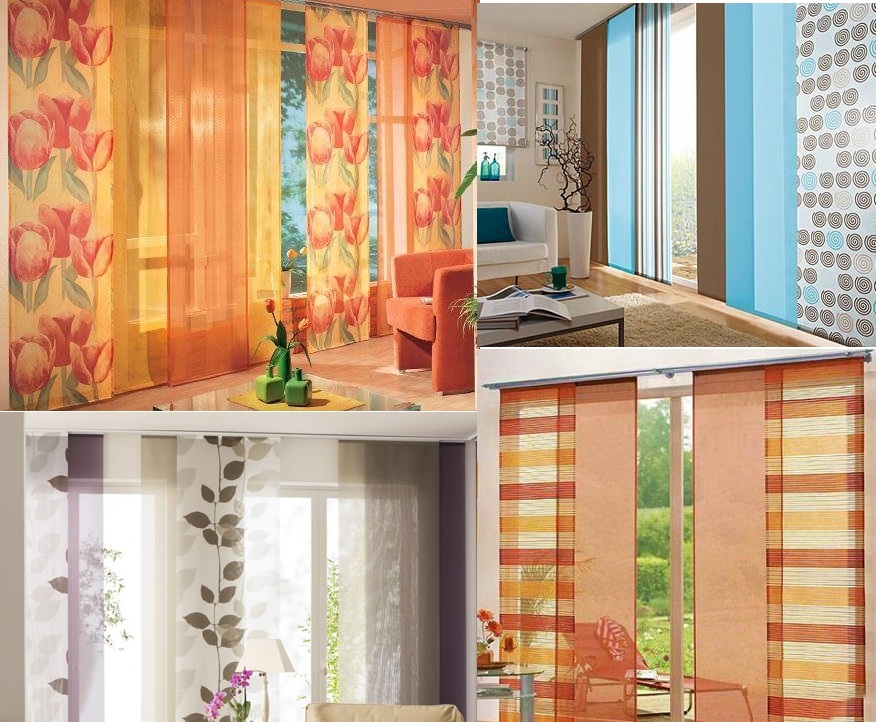
Scandinavian style- only light colors. Real Scandinavian-style curtains have a simple cut and natural color, are sewn from thin linen, translucent cotton, silk, muslin, muslin, any light fabrics of satin and damask weave. They do not take up living space and soften the geometric shapes. 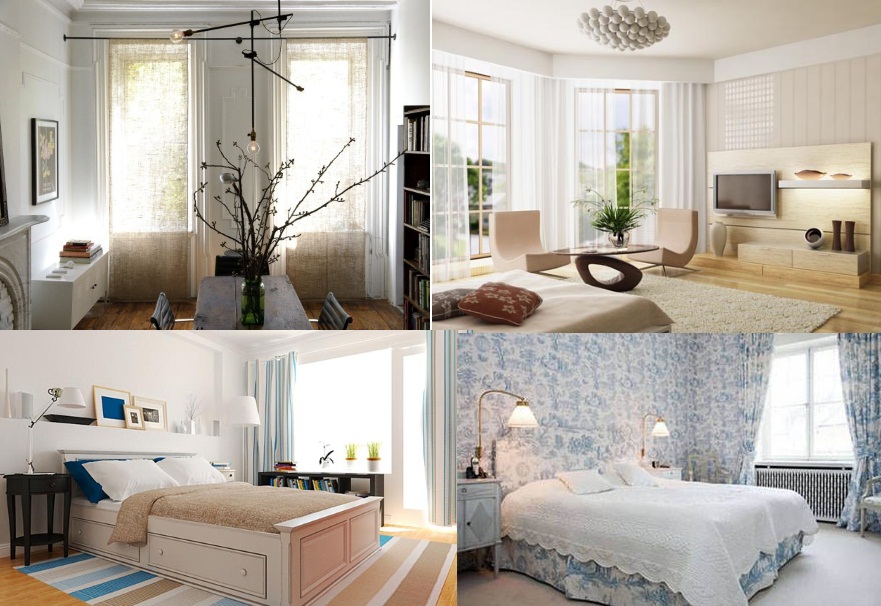
RURAL (RUSSIAN)- includes several directions united by natural fabrics, memories of summer and a bias towards nature. 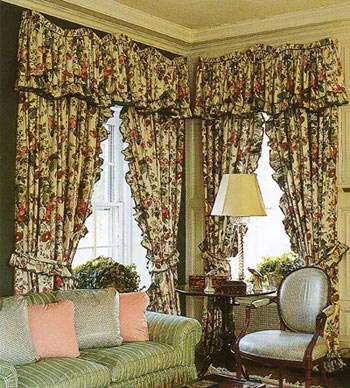
Cozy rustic style, characterized by cheerful colors, it is easy to emphasize using linen or any other coarse fabric with a pattern in checks, polka dots or natural colors. You can add old buttons, stripes, seams, ribbons made from natural materials. Curtains in country style have a light style, their movement will evoke the idea of a pleasant smell of freshly cut grass and a vacation ... it is supposed to use two panels that can have tiebacks and be combined with a lambrequin. The style allows you to decorate windows with homespun cloth or mesh. The curtains created using the patchwork patchwork technique look original.
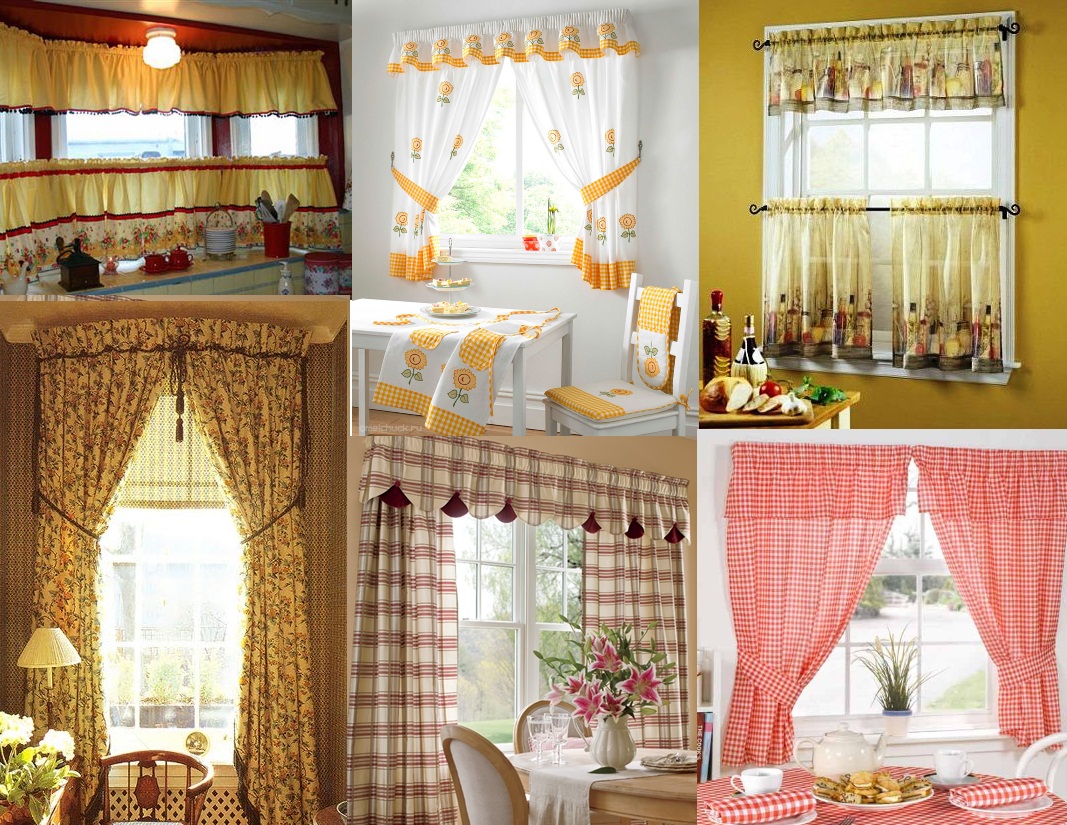
- combines the calm and soft colors of the Mediterranean nature: white, pistachio, blue, wheat, pink, lavender. All colors are pastel, they act soothingly, give a feeling summer heat and fresh field air. General trends - maximum lightness, simplicity, lack of pretentious details and a certain color scheme. The fabric used is light, airy (veil, organza and tulle), because these curtains should give the impression of air entering the room. 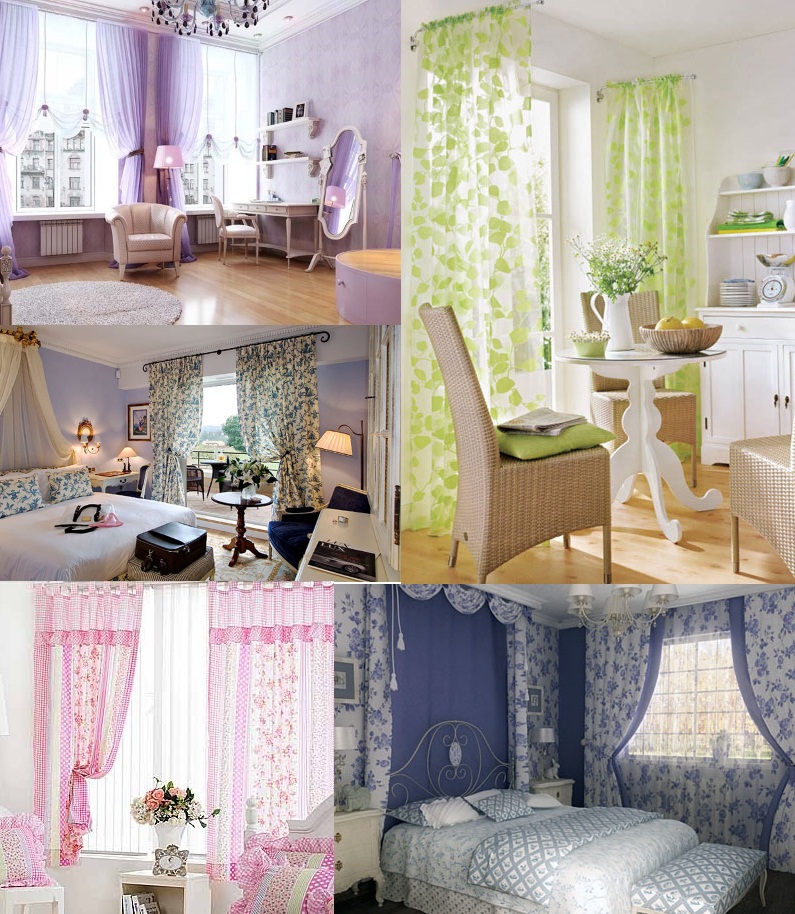
- classic curtains consist of tulle and curtains, if you choose an interesting fabric and show a little imagination, you can achieve interesting effects. Considering the purpose and origin of this style, silk, velvet, taffeta and lined fabrics are used for curtains. Tiebacks, brushes, lambrequins and decorative cords are used here. By using beautiful drapery curtains radiate solemnity and self-sufficiency. It also includes several subspecies that can not be used in every room, but only with high ceilings. 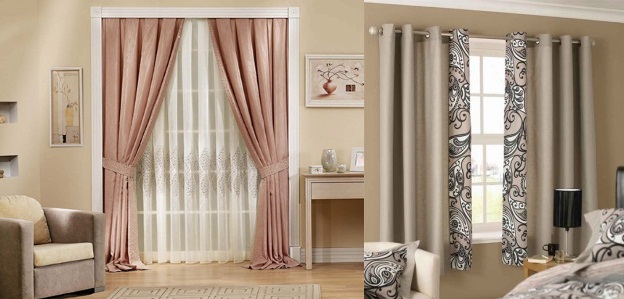
French- heavy, dense fabrics - velvet and velor, dark, rich colors, large floral and floral ornaments. Designed to emphasize the luxury of royal chambers, theaters and rich mansions. This style must be accompanied by rich antique furniture. 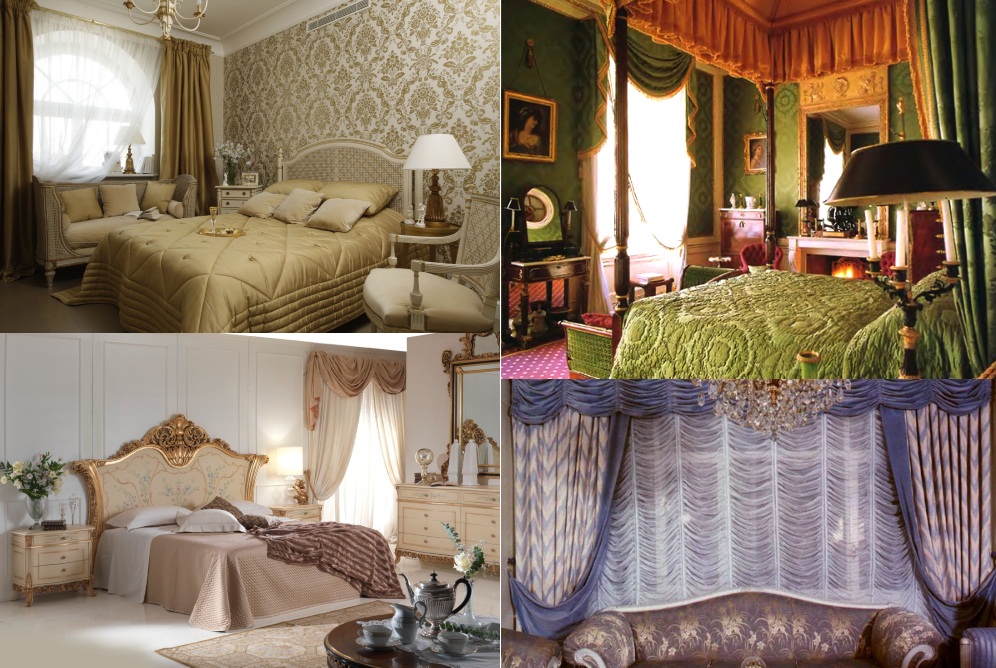
Palace style- This style was most popular back in the 17th century. Then it was used to decorate palaces and houses of other nobility. Today, this style has also retained its popularity; it differs from the French only in the use of decor and “gold-like” finishes. 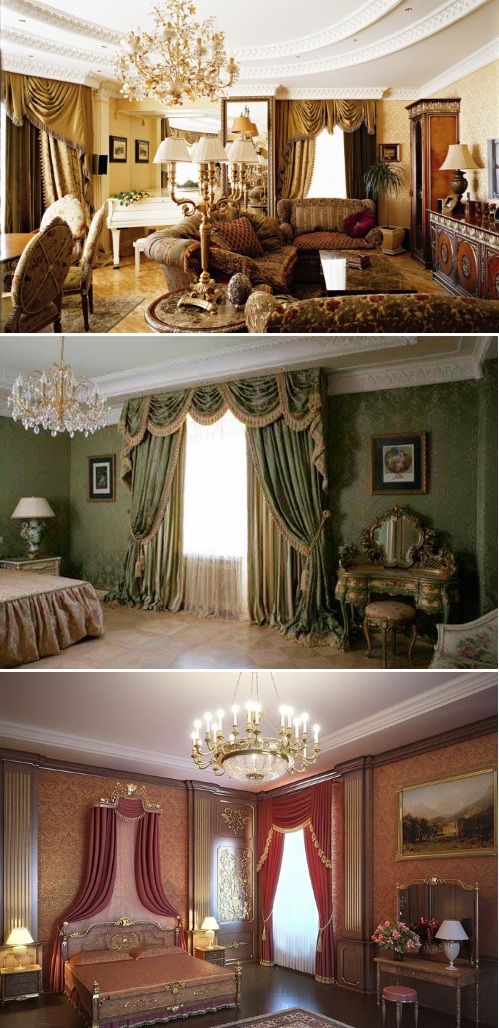
- the style is characterized by the use of lambrequins of a complex and rigid design, which are decorated with appliqué or embroidery in the form of fantastic flowers and leaves, and luxurious golden tassels that enhance the splendor of the composition. Fabrics are used dense, saturated colors, matte or with a satin sheen. 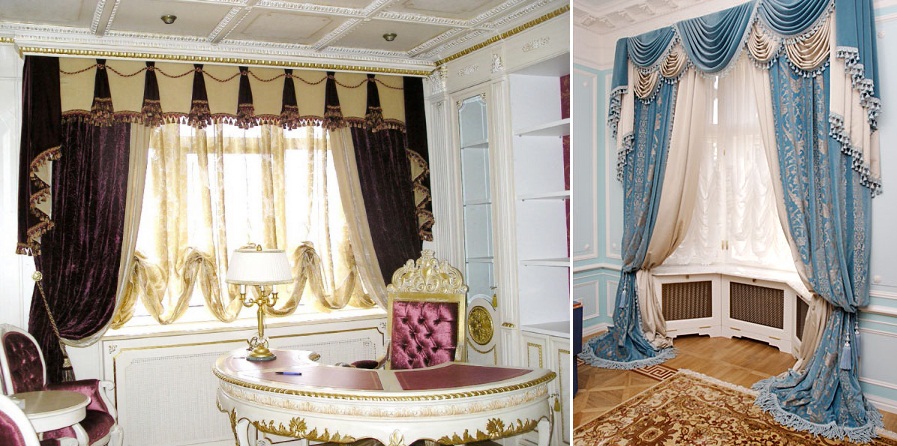
To classic style can also be attributed English, Austrian, Roman- so named according to the method of manufacturing and fastening curtains and the surroundings corresponding to the style.
MODERN (MODERN)– well suited for those who are accustomed to surround themselves bright colors and bold combinations. But there is a small hitch. Here you need to think through every detail to create a holistic image. If you cannot choose the shape, fabric, accessories and color of the curtains in accordance with your interior, then no matter how skillfully the curtains are made, they will look ridiculous. 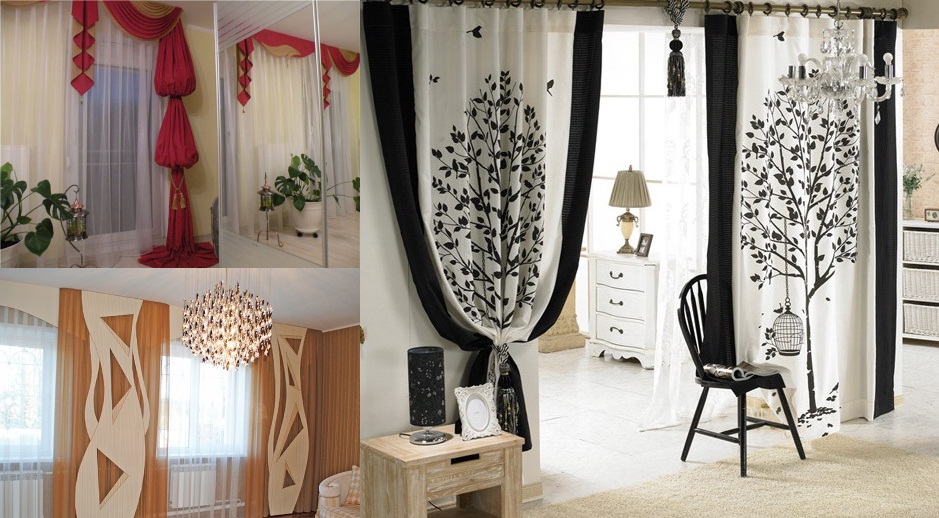
- the style is the most daring, since it is customary to use a simple cut, and the effect is achieved through fabrics with a non-standard texture and decoration details. 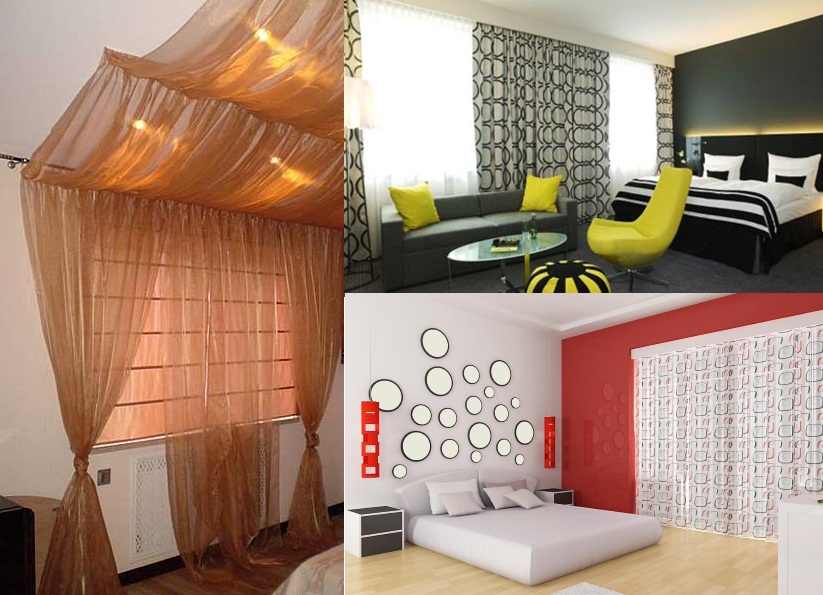
VINTAGE (RETRO)- things from the attic have found a second life: the furniture is restored with the preservation of obvious traces of time: cracks, scuffs, chips, scratches. Velvet, old-fashioned, reminiscent of shots from an old film of the last century, curtains are pulled out of the chests and knocked out from the dust. Treated with braid with bombs or tassels. 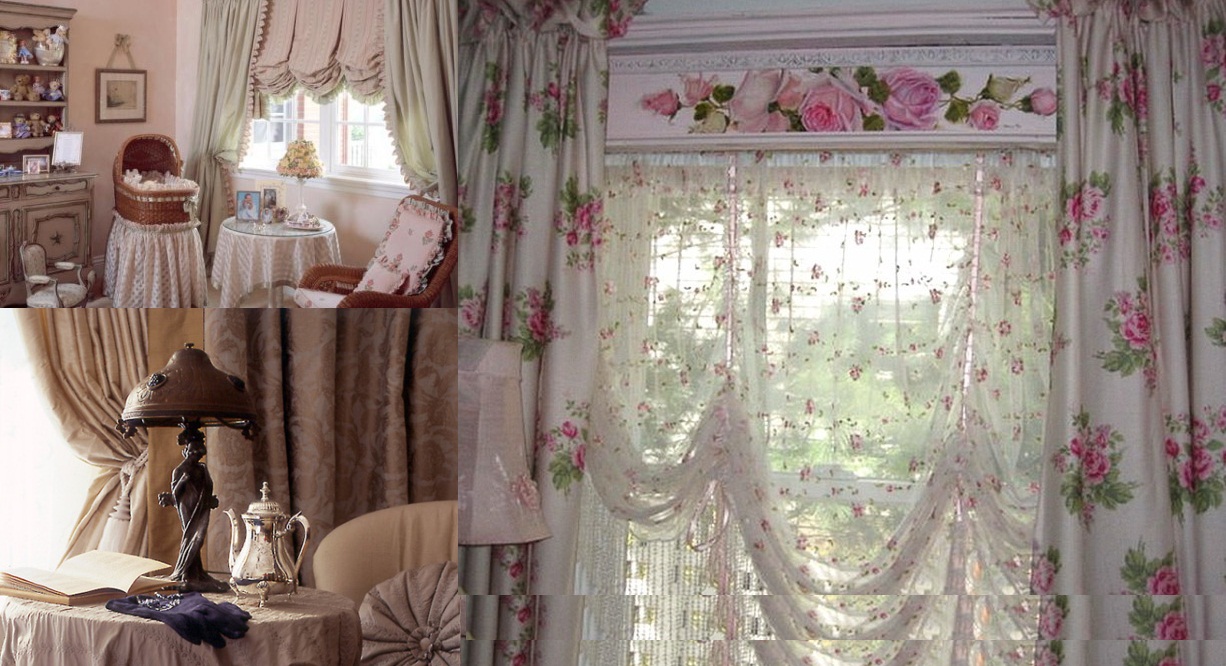
- a combination of incongruous - the essence of this style. If you manage to combine two different styles- the uniqueness of the interior is guaranteed. The rule here is such splendor multiplied by minimalism, pretentiousness is combined only with simplicity. Eclectic style, able to set the tone for the design of the entire room. If you are stuffed with ideas like a magic pot of porridge, then it is the eclectic style that will give space for activity. Any decor, in any combination - only the ability to feel the line beyond which bad taste begins can serve as a limitation.
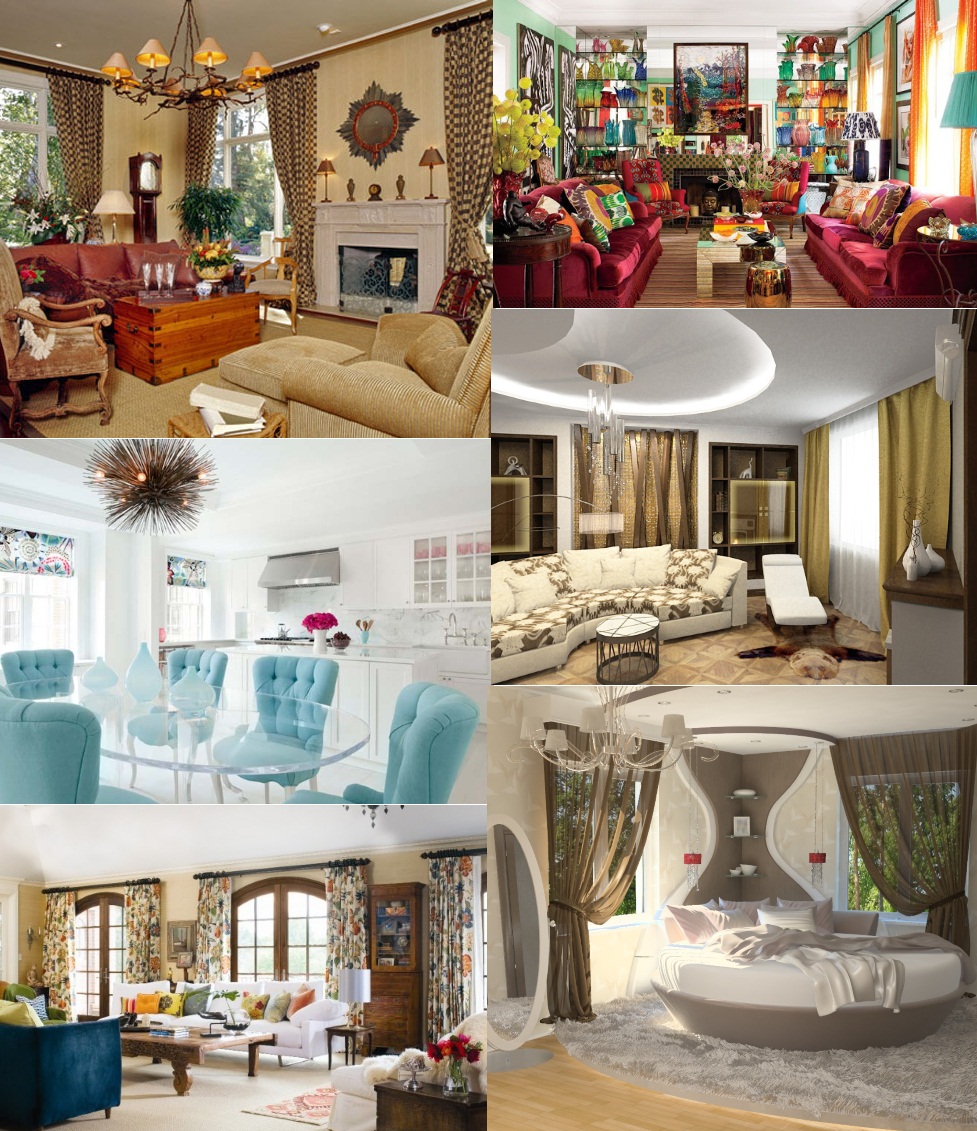
I hope this information gives food for thought and when the next post comes out, you will already have an idea of what kind of curtains and in what style you want to sew. Next time:
Materials collected from open sources, systematized and described by Angelina Vine.
Curtains are a symbol of comfort and decoration of the window of any home. The modern curtain market is represented by a variety of models and fabrics. Skillful housewives are quite capable of sewing tulle on their own.
Curtains will help complete the style direction of the room design and set the overall mood of the interior.
How to sew curtains? To get started, you need to correctly calculate the amount of fabric and familiarize yourself with the features of the cut. Sewing curtains yourself is not difficult if you follow the sequence of work and take into account the characteristics of the fabric.
The range of fabrics for window decoration is replete with variety: from sheer chiffon to stately brocade and velveteen.
When choosing a fabric, it is necessary to be guided by the characteristics of its strength. The material must be strong, dense and fire resistant. The fabric should be able to withstand washing and heat treatment with an iron.
Since the curtains are located directly at the window, they must be resistant to ultraviolet rays. A rag burnt out on the window will not add beauty to the interior.
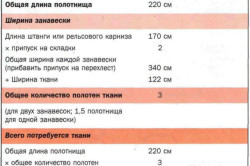
The width of the curtain should be 1.5-3 times the width of the cornice, taking into account allowances for hemming the edges. For organza tulle, the amount of fabric should be 2-3 times more so that soft air folds form; for tight shorts, material 1.5 times the width of the cornice is sufficient.
To start cutting, you must perform the following steps:
For an example of calculating an organza curtain, let's take a window 130 cm wide. The cornice for such an opening will be 150 cm in size. We multiply this size by 2 and add 10 cm for allowances. Thus, for this window with an assembly factor of ½, 310 cm of fabric and 350 cm of curtain tape. This calculation is also suitable for two-piece curtains, but in this case an allowance must be added of 15-20 cm.
If the fabric of the curtains has a pattern, then when purchasing, you should take the material with a margin, since you will have to combine the ornament. The stock of fabric is calculated as follows: the width of the pattern report is multiplied by the number of panels that will be combined.
There are fabrics in which the pattern also has a direction, that is, reports form rows: upper, lower, diagonal. This fact should also be taken into account in order to sew curtains with your own hands.
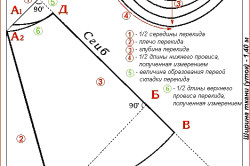
Before cutting the material, it must be washed and ironed. This is necessary in order to avoid stretching and shrinking of the curtains. In this case, the fabric must be ironed in a wet state. When the material dries, it is necessary to check it for the integrity and quality of the structure.
The cut of the fabric should be made according to the following sequence:
To properly cut and sew curtains with your own hands, you will need the following tools:
Sewing curtains with your own hands is not only the right cutting, but also the competent setting of the sewing machine.
Organza, tulle and drape fabrics require a specific thread tension setting and appropriate needles.
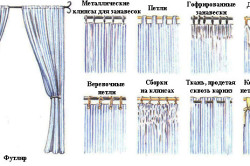
For thin organza, set the stitch length to medium so that the stitching does not pull the fabric. In this case, the thread tension and presser foot pressure should be weak.
Some housewives sew curtains, pulling the fabric with their own hands to avoid unwanted wrinkles. However, this is an erroneous technique, as it can lead to needle breakage and excessive stretching of the tissue.
Many curtain fabrics cannot be stitched twice, as they leave traces of needle punctures.
To avoid such possible consequences, you should take a piece of material and try to stitch it. The results of such an experiment will prompt the necessary parameters for adjusting the machine.
When sewing curtains, the following materials are needed:
When all the details are cut out, sewing materials are purchased and the machine is set up, you can start sewing curtains with your own hands. First you need to process the edges of the fabric so that it does not crumble.
Side cuts are processed into a hem or with the help of an oblique inlay. The process technology looks like this:
Next, proceed to bending the bottom. Curtains look more solid with a double wide hem of 5 cm, which is 10 cm in total.
The top hem of 2 cm is simply ironed and basted. A curtain tape is sewn to the folded edge.
On curtains, the pleats are laid either by hand and the braid is sewn over the folds, or formed by tightening the braid cords. The braid should also be with a margin.
It is necessary to cut the fabric so that the pattern does not turn out to be torn off. Therefore, it is necessary to take into account the stock of fabric when buying.
To sew curtains with your own hands, it is important not only to do the job well, but also to choose the right color scheme material. The curtain should fit into the interior of the room and look harmonious with all the objects in it.
How to sew curtains?
In principle, nothing is impossible. Curtains you can sew yourself. For curtains of this design, a pattern is not needed. Need a meter tape, pins, scissors
, sewing machine and great desire.Now let's deal with curtains with eyelets , which are worn directly on the rod of the eaves.
Another 5 cm must be added to the length from the floor to the cornice. After all, the cornice will be on the same level with the rings - and a few centimeters of fabric on top. If the curtains are up to the window sill, 10-15 cm are left on the filing. For touching the floor - 20 cm. For lying on the floor - 2-3 cm. This is what design you choose. The fabric width is calculated as follows: multiply the window width by 2 (4m + 3m + 8.8m). You also need folds for beauty.
The stores sell special tapes with rings already punched. They make the task much easier! The number of rings should be even (so that the folds go to the wall).
The length of the ribbon is equal to the length of the fabric minus 10 cm.
Iron the hem of the top of the curtain and place the tape just above the hem. Baste or pin with pins. Then attach to the fabric with two seams: top and bottom. If the fabric is thin, then it is better to make the hem larger, in several layers.
Twist the fabric twice, and sew with a straight stitch, trying to capture the right and left edges of the ribbon with rings.
Then - carefully cut the fabric inside the rings.
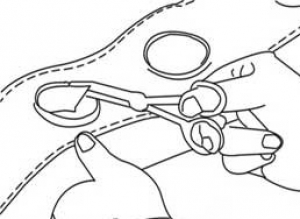
Flip to the right side and insert the rings, tucking the edges of the fabric under them.
It remains a little - to process the bottom edge of the curtains. Trust your husband to hang the curtains!
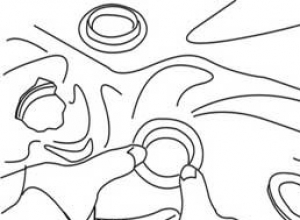
How to sew a pelmet. Lambrequin pattern.
She herself recently pestered acquaintances with the question: how to sew a lambrequin. A friend gave me a pattern. I sewed it, it turned out well. 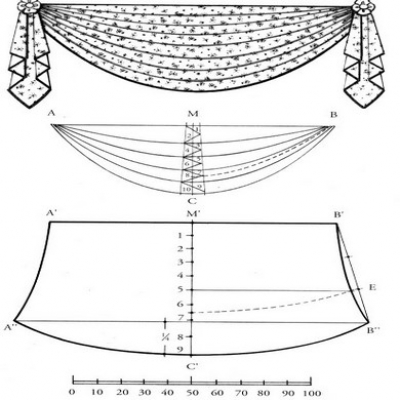
Found cool pattern "svaga".
Everything is clearly lined and written here, for those who are especially gifted, like me =) I think that such a pattern will suit you and you can sew a lambrequin for yourself without any problems. 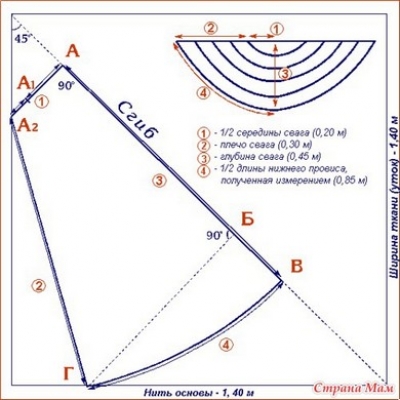
In finished form, such a set of curtains with a lambrequin will come out. Not bad, right?
. You can choose any fabric. In this option, all the details of the curtains and lambrequin are clearly visible.
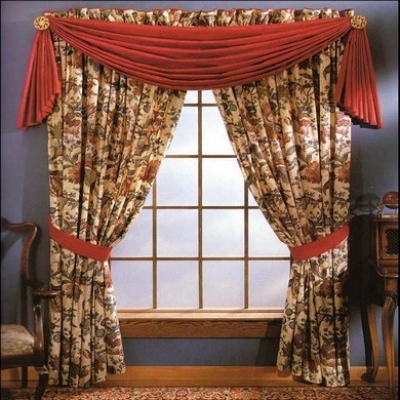
Where does the process of creating curtains actually begin?
First you need to think about the design of the curtains, and then pick up curtain fabrics, cornices and decorative ornaments, while taking into account the overall interior of the room. However, for talented people this is unlikely to be an obstacle. So, if you have creativity, design skills or just a great desire to update the interior of your home, as well as a sewing machine, threads, needles and other little things, then you can safely start.
First of all, you need to clearly imagine what kind of future curtains will have, and then make a sketch, you can use a pencil on paper. By the way, in order not to fool yourself with the creation sketch(not everyone has artistic ability) ready-made patterns easy to find for free in a magazine or on sites that specialize in tailoring curtains. After choosing a suitable model, we buy required amount fabrics, and then strictly adhering to the recommendations, we sew curtains. For those who have certain skills, the process is not difficult. However, any creative process is always joy and pleasure.
You can go the other way, that is, do without any patterns. It is enough just to take measurements of the window (length and width), then, taking into account the length of the curtains, calculate the amount of fabric required for sewing.
Although modern fabrics shrink already during the production process, it is still better to verify this personally. Therefore, before starting work with the fabric, it is advisable to wet it, and then, if necessary, carefully iron it.
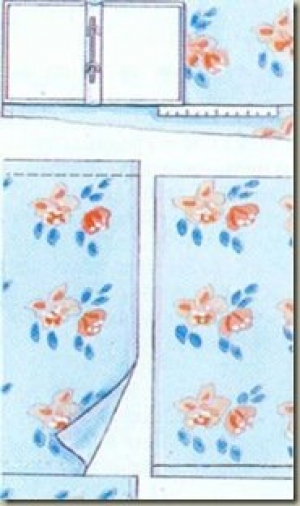
For cutting curtains, the fabric must be laid out, for example, on the floor, and the front side should be at the top. Then you need to determine the bottom edge of the curtain and align it by drawing a line perpendicular to the side edge of the fabric. Cut the fabric along this line. Next, set aside the length of the curtain determined in advance and cut the fabric along a line perpendicular to the side edge. The second part of the curtain should be cut out in the same way, having previously joined the pattern.
After the two panels are ready, they must be hemmed from the bottom, and a special tape is sewn to the upper edge, on which there are loops for attaching the curtains to the eaves. In addition, ready-made curtains can be decorated with frills, lace, tassels, and elegant braid.
When sewing curtains, there are three main sizes that are crucial for choosing a style and style. The curtain can have three lengths - A, B, C. Length A - to the window sill, length B - 15 cm below the window sill, length C - to the floor level. Therefore, depending on what kind of curtains you plan to sew, it is necessary to accurately and carefully measure the length of the fabric.
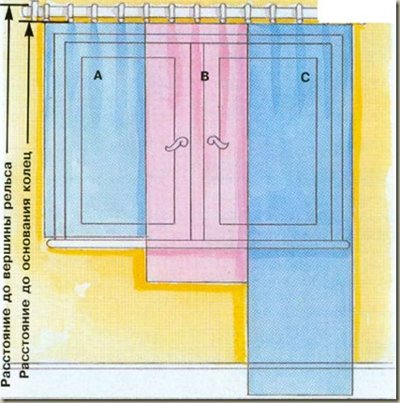
Most simple curtains
are a flat panel of such transparent fabrics as veil, cambric, muslin, cotton. Such curtains are draped with a special braid and hung on a light wooden or metal cornice. The main thing when sewing a thin curtain is to correctly calculate its length. A curtain made of a denser and more opaque fabric can be decorated with a decorative ribbon or border.
If the room for which you decide to sew curtains is decorated in country style, then you can create excellent curtains using the patchwork (patchwork) technique. This is especially convenient for housewives who are engaged in needlework, since multi-colored patches will be needed for sewing curtains. You can also use fabric that has already been used. First, pieces of fabric need to be washed and ironed, then cut out with a stencil, and then sewn together. It is most convenient to work with fabrics of the same type. In patchwork, the pattern, as a rule, consists of parts of the same size and shape, for example, squares, rectangles or other shapes. To make the curtain durable, the patches sewn into the cloth are attached to the lining. Ribbons, braid and cords are used to decorate such curtains.
Art Nouveau fans can easily create suitable curtains that are distinguished by a fairly simple cut. For sewing such curtains, you will need a capron or nylon of bright colors and a metal cornice with tips in the form of an arrow, a cone, etc. The main plot of the design of Art Nouveau curtains is asymmetry, as well as light and sophisticated draperies. The canvas of airy fabric, without being fixed, simply pounces on the cornice, twisting around it like a graceful wave. In addition, an Art Nouveau curtain can be made from a regular rectangular piece of light fabric, pulled together with a cord or ribbon at the level of the window sill and secured on either side with a holder.
For creating classic curtains
it will take a lot of attention and work, since such a curtain consists of three components - a thick curtain, a light curtain and
lambrequin. The main task when sewing classic curtains is to make the right pattern, and then follow the sewing recommendations exactly. Although the creation of a complex curtain will take you some free time, but it will be the work of your own hands, which is especially expensive and valuable.
![]()
If you decide to sew curtains yourself or you are going to order their tailoring in the salon, but decided not to invite the designer to your house, you need to measure the curtains.
Proper sizing of curtains is extremely important, because even a mistake of 2-3 cm can spoil the whole picture. If you are going to order tailoring of curtains in the salon, keep in mind that when placing an order you will be asked to put your signature in order to certify the correctness of your measurements.
Carefully check that the manager placing the order indicated exactly the dimensions that you named. If the curtains, sewn, according to the sizes indicated in the order form do not suit you, then changing the size of the model will be made out by a separate order and paid separately.
To prevent this from happening, it is enough to know a few simple rules for sizing curtains. First, in order to measure curtains, be sure to install the curtain rod first - accurate measurements can only be obtained when the curtain rod is installed. 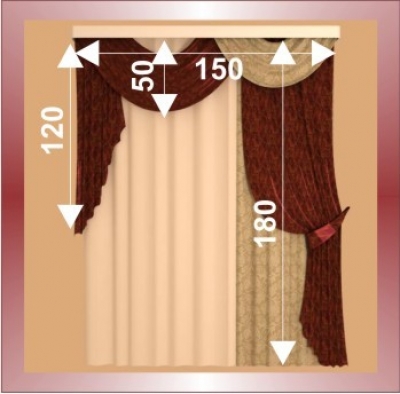
In order to measure the height of the curtains, take measurements from the cornice hook to the floor in three or more places. This is necessary in order to exclude the curvature of the floor and ceiling, if the dimensions match, subtract from the result the distance that the curtains should rise from the floor. To measure the width of curtains, measure the distance between the extreme positions of the curtain rod hooks. If you plan to sew curtains with variable heights (for example, "Arch"), mark two or more height points - a bottom edge point, a top rise point, etc.
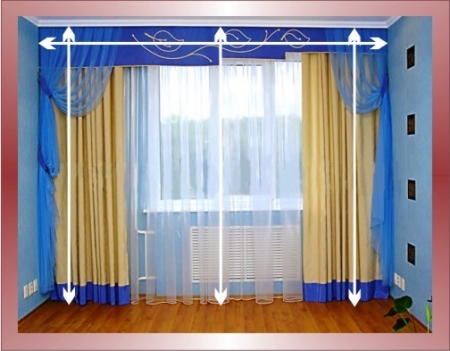
If you have an inclined cornice installed above the window (as a rule, this window design option is found on stairs, or country houses and cottages in rooms under the roof), you will need to take the following measurements: the length of the cornice, and the length of the cornice in a straight line.
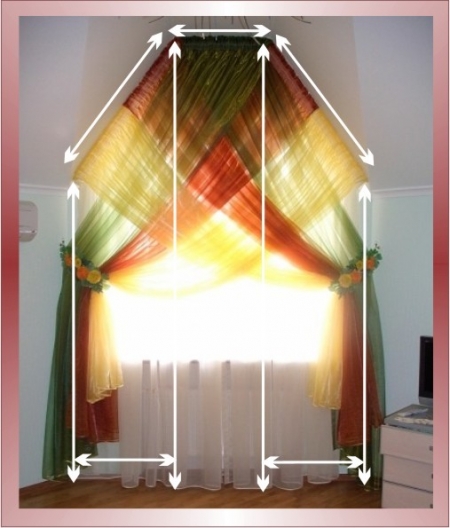
If the cornice itself has the shape of an arch, you will need to remove the pattern.
If you decide to sew curtains yourself, first of all you need to calculate the fabric
To do this, you need to decide on the choice of fabric and clarify its width.
Drapery fabrics and tulle are available in widths of 1.50 m (options from 1.40 to 1.60) or heights of 2.80 (options from 2.70 to 3.20 m). As a rule, designers try to avoid fabrics with a width of 1 ,50 m., because, other things being equal, curtains sewn from a fabric 2.80 m high are more economical. In addition, it is simply impossible to carve out many curtain elements from narrow fabric. Therefore, we will calculate the fabric for curtains based on a height of 2.80 m.
And so, in order to calculate the amount of fabric that will go to the manufacture of curtains, you need to know the width of the cornice. If the fabric is dense enough and has a large pronounced pattern, it is enough to take one and a half widths of the cornice, that is, the width of the cornice must be multiplied by 1.5. For example, the width of the cornice is 3.00 m., 3 x 1.5 = 4.5 m. We will need fabric. Immediately it is worth mentioning that this is the most economical, but far from the most aesthetic option.
A curtain laid in a bow fold or on a special braid will look much more beautiful. The bow pleat can be laid starting from double the width along the eaves, but the most advantageous result is achieved when the width of the cornice is exceeded by 2.5 - 2.7 times. That is, with a cornice width of 3.00 m - 3 x 2.7 = 8.1 m of fabric. If you plan to collect fabric on a special mounting tape, ask the sales assistant how much fabric you need to take for the tape you have chosen. In any case, do not forget to add another 10-20 cm to the footage you received for processing the side seams.
Thus, you can calculate the fabric that will be needed for sewing shadow curtains and inner tulle. In order to make a calculation of the fabric that will go to the lambrequin, you will need to calculate the fabric consumption for each element separately and then sum it up. A standard swag takes 1.5 m of fabric, with a fabric height of 2.80, out of 1.50 m It is possible to carve out two standard swags. To calculate the fabric consumption for de jabot, you need to take a piece of fabric equal to one height and width, taken in three times + allowances for seams. For example, we will have a dejabot 1.20 m high and 0.30 m wide, we will need: 0.3 x 3 + 0.1 = 1.00 m. If we sew from fabric 2.80 m high. - 1 m will be enough for two dejabots.
Calculating fabric consumption for Roman blinds and Japanese panel curtains is much easier. Since the curtains are not pleated, simply take the width (or height, if the fabric is 1.50 m) of the curtain and add seam allowances. But one important point must be kept in mind: if we sew panels of fabric with a large, pronounced pattern, 1.50 m wide, we will need to take additional footage to adjust the pattern.
If the model has a rigid lambrequin on a bondo or glued fabric, take the size of the finished lambrequin, add allowances for the seams and add 20 - 30 cm to fit the fabric on the glued fabric. For example, if the lambrequin is 3.00 x 0.50 m wide. 3 + 0.2 + 0.3 = 3.50 m. in height, while leaving a lunge from a height of 2.80 m. - 1.20 m. = 1.60 m.
If you are not embarrassed by the seams on the lambrequin or they can be covered with other elements, such as a swag, then you can calculate the fabric consumption for a hard lambrequin as follows: 3.00 m x 2: 2.80 m (fabric height) = 2.14 - Round up to the nearest integer - we need 3 lambrequin heights. (0.50 m. + 0.2 m.) x 3 \u003d 2.10 m. of fabric will go to a hard lambrequin with a seam.
FABRIC CONSUMPTION CALCULATION:
Decide on the length of the curtain: it can be on the floor (do not reach the floor level by 13 mm), be 8 cm below the window sill, or be flush with the window sill (the length is measured from the cornice to the window sill). At this stage, the length does not include a drawstring allowance at the top and a hem allowance along the bottom line.
WIDTH
Measured along the side borders of the eaves. Lay the allowance for the entry of the canvases in the center. If the window is close to the corner, then the width is measured taking into account the distance from the window to the corner. If it is less than 20 cm, then you will not have enough space between the wall and the window to open the curtains normally, so think about the option when one panel hangs on the other side.
CURTAINS:
The fluffiness of the curtain is determined by the density of the fabric and the type of upper drawstring. For example, deep narrow pleats will require 3-3.5 fabric widths, while inverted-V pleats will require 2 ¼ widths.
The general rule is: dense fabrics have a splendor ratio of 2:1. medium density fabrics - 2.5:1, light fabrics - 3:1.
CONNECTION OF CURTAIN PANELS BY LENGTH
Sometimes sewing curtains involves connecting several canvases along the length. When you make calculations, round up the value. For example, if the window is 220 cm wide and you want 2 ¼ fluffiness, you will need 495 cm of fabric divided into two 248 cm strips. With a fabric width of 140 cm, the required width for each canvas would be 1.8 panels.
Rounding up, we get 2 panels per canvas (in this amount we can include allowances for side hem and connecting seams).
CURTAINS ON THE CURTAINS, HIM, REPEAT THE PATTERN
Before determining the right amount of fabric for sewing curtains, you will have to take into account such factors as the repetition of the pattern, the type of drawstring on the top of the curtains and the hem allowance. The size of the pattern is determined by the boundaries beyond which the pattern is repeated. The size of the pattern is either calculated independently, or indicated on the coupon-description of the fabric. Add a pattern size for each desired length to get the desired panel size.
Drawstring on the top of the product. Add double the width of the drawstring (it varies from 2.5 cm to 20 cm). The inverted V drawstring width is 10 cm, so the total amount of material used is 20 cm. The length of the drawstring will be equal to the total width of the product plus 15 cm for hem.
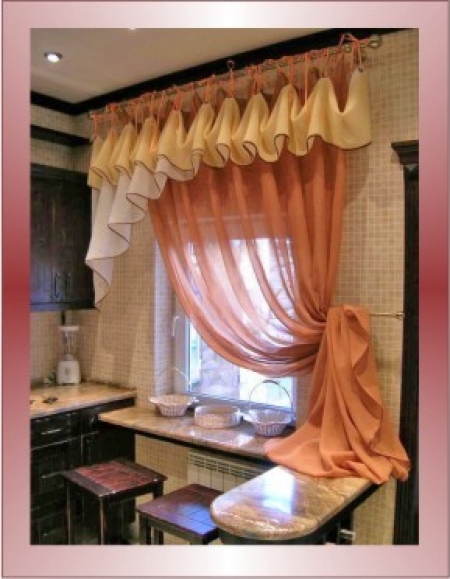
Details? This will be an article: how to sew curtains master class. In it you will learn how to sew beautiful curtains. This will be information on how to sew simple curtains.
The portiere is a curtain from dense fabric. Curtain is a curtain made of thin fabric. The difference between curtains and curtains in one technological operation, due to the density of the fabric. Also the difference in allowances, due to the thickness of the fabric. The bottom of an organza curtain, for example, can be overlocked by inserting a fishing line or thick tape into the edge when overlocking. Also, for thin fabric, it is permissible to plan an allowance for the bottom of the curtains 2 cm, 1 cm each (). And for thick fabric, you need to plan at least 4 cm, 2 cm hem (hem seam with a closed cut), because if you plan only 2 cm, then such a hem will not turn away reverse side and look bad.
How to calculate the curtain, you can see in this article.
1. We find the face and the wrong side of the fabric. The face of the fabric will look into the room. First, we process the sides with a hem seam with a closed cut. Since we have a dense fabric, I laid an allowance for processing the sides of 8 cm. So, we tuck 2 cm, and then we tuck another 2 cm, 4 cm came out on one side and 4 cm on the other.
2. We process the bottom of the curtain, with a hem seam with a closed cut(if we planned so). We tuck 5 cm, and then another 5 cm, it turns out that only 10 cm were taken to hem the bottom.

3. Now it's the turn of sewing on the tape for the curtains. Here you need to turn Special attention for what you need correctly find the face of this tape, it is very often confused with the wrong side, and then you have to change the entire tape. Look at the photo, I lifted the sewn-in ribbon with my finger. On the inside, it does not rise at all, whereas on the face, it rises through the dotted line.
Therefore, look carefully: where you can lift a sewn narrow ribbon with your finger - this is the face of the ribbon. You will then attach hooks to this narrow ribbon to hang the curtain. There are two of them in the tape, you can hang the curtain by the top tape, or you can hang it by the bottom one. Accordingly, your curtain will hang higher or lower.
We do not cut the tape itself from the roll and do not cut ahead of time! We sew directly from the roll, and then cut off the unnecessary.
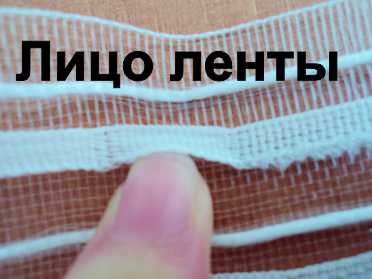
4. Lay the fabric face up, put a 2 cm ribbon under the bottom. Then we wrap the cut of the fabric with tape.
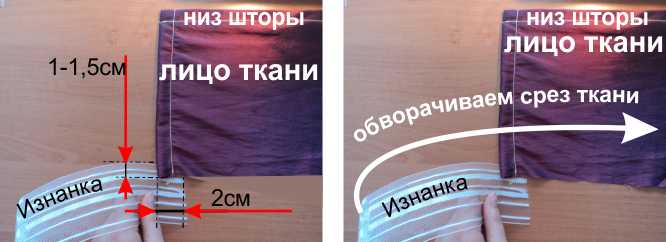
5. And we attach 0.1 cm from the edge of the tape. When we finish this line almost to the end, we turn the other edge in the same way.

6. We turn the tape inside out, making a 1-2mm overlap so that 1mm of the tape does not peek out from the face.
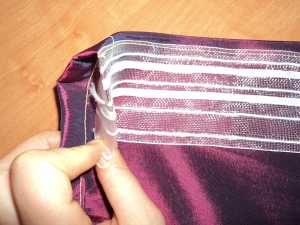
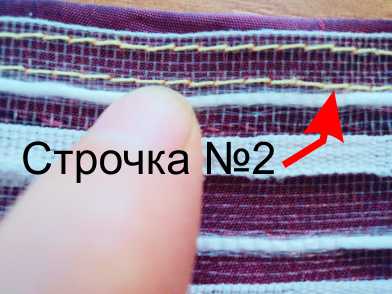
8. We take out with a pin or hands the laces for tightening from under the allowance.
![]()
8. We scribble the rest of the lines where we like, I did it as in the photo, and you can build a little differently. The main thing is to make sure that the tape does not warp. It is better to lay out the fabric and ribbon evenly and chop them with pins.
It is also better to make stitches one after the other and towards each other in order to avoid tape distortions. When attaching the tape, do not accidentally grab the laces, otherwise they will not pull together.
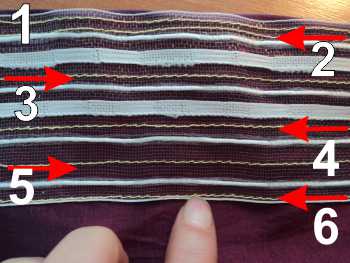
9. We tighten the tape by the laces, beautifully laying out the folds on the face. And we tightly tie the laces in two, not four, so as not to tighten the edge. The laces can be cut, leaving the ends 5 cm each, or you can sew bags and fold them there without cutting the laces at all, I sewed such bags, but during operation I see that it was better to tie them and immediately cut them off, and put the ends of the cut laces under a transparent tape so they don't stick out.
You can bring the ends of the laces under the tape with an ordinary thin hook.
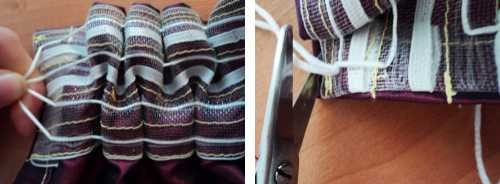
10. Here is our finished face view. The stitches can be made with contrasting threads, or you can choose them in the color of the fabric, see for yourself which design you like best.
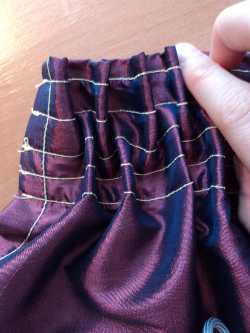
But I sewed this curtain for myself in the hall. In my opinion, it turned out quite solidly to sew curtains beautifully.
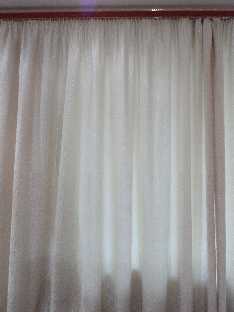
P.S. Where to lay the lines on a narrow ribbon if you sew a curtain? Tailoring is exactly the same, and look at the lines in the picture.
Similarly, you can sew curtains for the kitchen. If you have little space, you can simply make it shorter, then it will seem. that there are more places.
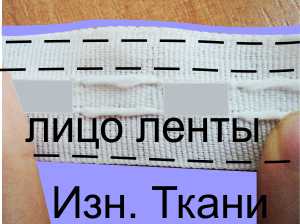
Some visitors ask how to sew curtains for the kitchen. I answer - just like ordinary curtains. You can only make it shorter in length, not reaching the floor by 20-30cm or more, so that the curtains do not take up much space.
I think now you know how to sew curtains yourself and you will definitely succeed!